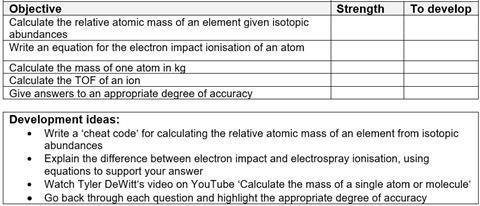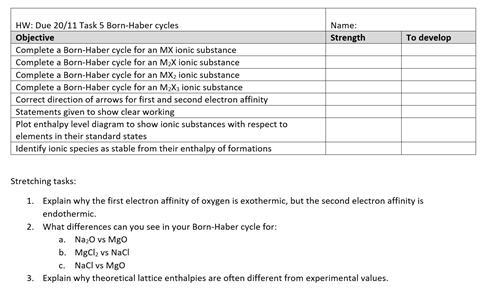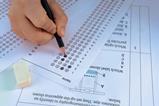Use objective-based marking to save time and support students in taking ownership of their learning

During school closures, the biggest challenge I faced was my marking workload. The painstaking task of meticulously going through work submitted online and trying to provide some meaningful feedback for students caused me to burn out quickly during lockdown. Although I was expecting students to respond in the same way they do in face-to-face lessons, as time went on, I felt more and more unsure about the degree to which this was happening, which made the laborious process feel somewhat meaningless. As we continue to mark work online, I knew I needed to change tactics, not only to make the process less time-consuming for me, but also to make it more engaging for my students.
The most obvious way to cut my workload was to strip back tasks to the bare essentials. I considered the intended purpose of the homework task: did I want students to consolidate knowledge, practise skills or combat misconceptions? This thought process led me to integrate objective-based marking into my practice. This involves giving students a feedback sheet with a list of objectives and development ideas, and they then mark each objective as a strength or development point.
The most obvious way to cut my workload was to strip back tasks to the bare essentials. I considered the intended purpose of the homework task: did I want students to consolidate knowledge, practise skills or combat misconceptions? This thought process led me to integrate objective-based marking into my practice. I give students a feedback sheet with a list of objectives and development ideas; they mark each objective as a strength or development point. You can find an example in the downloads.
Ultimately, objective-based feedback has allowed me to invest my time in a meaningful way. It has changed the way I see homework and feedback, and provided opportunities for my students to engage with their own learning process. This article explains my approach and gives you some ideas on how to integrate it into your own practice.
Download this
Objective-based feedback sheet templates for you to use with your own students when giving online feedback, as MS Word or pdf.
Objective-based feedback sheet templates for you to use with your own students from the Education in Chemistry website: rsc.li/2KMYliv
Step 1: Model selecting objectives and development ideas
For one homework task, I gave students exam questions to practise on time of flight mass spectrometry. I reviewed each question, breaking it down into key steps, particularly for multi-step calculations, using the mark scheme to help guide me. As I marked each students’ work, I selected common errors and added these to the list. In this example, I added ‘give answers to an appropriate degree of accuracy’ when I noticed some students gave five or six significant figures in their answer. I also picked out strengths in their work to ensure the feedback was balanced and not a purely negative, critical process.

When doing this yourself, think about the purpose of the task, breaking it down into key objectives. Your exam board specification is a good starting point for this – I use the ‘Students should be able to’ statements to guide me, for example.
In our next lesson, I provided students with their completed grids and encouraged them to look at their online feedback, picking out their strengths and areas for development within their work and using the development ideas for tasks to help them improve.
Step 2: Get students to take ownership
Once students were used to this form of feedback, I began providing incomplete grids to fill out based on my online marking, encouraging students to recognise what my feedback meant in terms of their strengths and targets. Eventually, I began giving only completed grids with no additional marking, prompting students to pick out their mistakes in each question from their targets in the grid. This made the feedback experience more focused, and students enjoyed taking ownership of their own progress. I now even leave some rows blank, giving students the opportunity to recognise the objectives of each question for themselves and set their own strengths and targets.
With your own class, provide students with their marked work and the grid, reviewing each objective. You could encourage colour-coding of each objective within their work, or annotate on the grid to show which question each objective relates to. Once they are more confident in identifying their strengths and targets, you can encourage students to fill out their own grids. Eventually, with practice, you will be able to provide students with grid-only marking, prompting them to identify mistakes in their work. I have particularly enjoyed encouraging my students to come up with their own objectives; getting them involved in their own pedagogy has been insightful, as well as helpful for both my teaching and their learning.
Step 3: Include stretch tasks

To extend this idea further, I have begun including stretch tasks for students who have scored full marks, such as in the example below on Born–Haber cycles. This sends the message that there is always progress to be made, giving all students equal amounts of work to do, rather than giving the most work to the least successful.
To extend this idea further, I have begun including stretch tasks for students who have scored full marks. This sends the message that there is always progress to be made, giving all students equal amounts of work to do, rather than giving the most work to the least successful.
Although the initial process can be time-consuming, over time my workload has reduced dramatically. Above all, the process feels much more positive and worthwhile, both for me and for my students. It makes me question why I am setting homework, so the tasks I set are more purposeful. Giving students tasks to do beyond simply reading through my comments has forced them to proactively engage with feedback. The grids have helped students to understand exactly how to improve their work and have prompted them to be more objective-focused when assessing their own understanding. The grids have also been an invaluable resource in preparing for end of topic and mock examinations, highlighting where students need to invest their time. I have been pleasantly surprised at how valuable so simple a task can be in promoting progress. Objective-based marking is definitely something I will be continuing with beyond the pandemic!
Louise is a teacher of chemistry at an independent girls’ school in Greater London
Downloads
Objective-based marking grid template
Editable handout | Word, Size 67.68 kbObjective-based marking grid template
Handout | PDF, Size 33.12 kb














No comments yet